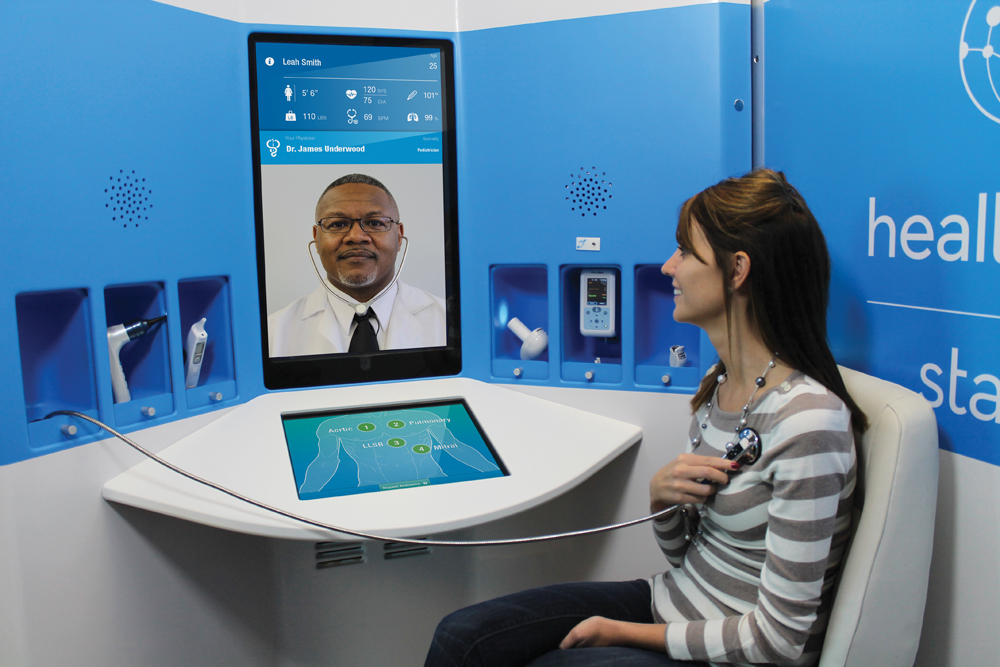The HealthSpot station is an 8x5-foot, ADA-compliant mobile kiosk that lets patients access a network of board-certified physicians through interactive videoconferencing and medical devices, such as stethoscopes, scanners, and thermometers. From that information, the remote doctors can make diagnoses and prescribe advice and medicine.
“We’re bringing the doctor to the patient,” says Steve Cashman, CEO and Founder of Dublin, Ohio-based HealthSpot, which launched its first station at the Consumer Electronics Show last December.
As of mid-October, about a dozen HealthSpots were in use. Eight healthcare systems in Minnesota, Miami, San Diego, and Ohio—including the prestigious Cleveland Clinic—were making caregivers available. Customers can be treated for common health conditions—colds and flu, rashes and skin conditions, eye conditions, earaches, and seasonal allergies.
On November 10, pharmacy chain Rite Aid announced that it had entered into an agreement with HealthSpot to install stations at select Rite Aid locations in the Akron/Canton, Cleveland, and Dayton/Springfield markets in Ohio.
The HealthSpot station was designed by Cleveland-based architectural firm Nottingham Spirk. Bill Nottingham, a Principal, says the station had to be portable, but not so small as to feel claustrophobic. An arched ceiling gives the pod some breathing room
Ohio-based Commercial Vehicle Group, a manufacturer of truck cabs, makes the stations. The units are shipped in pieces and reassembled on site. HealthSpot is providing the units to client locations for a one-time implementation fee to cover the installation, plus a monthly maintenance and licensing fee. Cashman estimates the stations are profitable when they handle at least six patients a day.
Cashman says he plans to place another 100 HealthSpots into the market in early 2015. He says he envisions them being installed on college campuses, in retail malls, and in assisted living facilities.
Read about more innovations from BD+C's 2014 Great Solutions Report
Related Stories
| Dec 17, 2010
Vietnam business center will combine office and residential space
The 300,000-sm VietinBank Business Center in Hanoi, Vietnam, designed by Foster + Partners, will have two commercial towers: the first, a 68-story, 362-meter office tower for the international headquarters of VietinBank; the second, a five-star hotel, spa, and serviced apartments. A seven-story podium with conference facilities, retail space, restaurants, and rooftop garden will connect the two towers. Eco-friendly features include using recycled heat from the center’s power plant to provide hot water, and installing water features and plants to improve indoor air quality. Turner Construction Co. is the general contractor.
| Dec 17, 2010
Toronto church converted for condos and shopping
Reserve Properties is transforming a 20th-century church into Bellefair Kew Beach Residences, a residential/retail complex in The Beach neighborhood of Toronto. Local architecture firm RAWdesign adapted the late Gothic-style church into a five-story condominium with 23 one- and two-bedroom units, including two-story penthouse suites. Six three-story townhouses also will be incorporated. The project will afford residents views of nearby Kew Gardens and Lake Ontario. One façade of the church was updated for retail shops.
| Dec 17, 2010
ARRA-funded Navy hospital aims for LEED Gold
The team of Clark/McCarthy, HKS Architects, and Wingler & Sharp are collaborating on the design of a new naval hospital at Camp Pendleton in Southern California. The $451 million project is the largest so far awarded by the U.S. Navy under the American Recovery and Reinvestment Act. The 500,000-sf, 67-bed hospital, to be located on a 70-acre site, will include facilities for emergency and primary care, specialty care clinics, surgery, and intensive care. The Building Team is targeting LEED Gold.
| Dec 17, 2010
Arizona outpatient cancer center to light a ‘lantern of hope’
Construction of the Banner MD Anderson Cancer Center in Gilbert, Ariz., is under way. Located on the Banner Gateway Medical Center campus near Phoenix, the three-story, 131,000-sf outpatient facility will house radiation oncology, outpatient imaging, multi-specialty clinics, infusion therapy, and various support services. Cannon Design incorporated a signature architectural feature called the “lantern of hope” for the $90 million facility.
| Dec 17, 2010
Cladding Do’s and Don’ts
A veteran structural engineer offers expert advice on how to avoid problems with stone cladding and glass/aluminum cladding systems.
| Dec 17, 2010
5 Tips on Building with SIPs
Structural insulated panels are gaining the attention of Building Teams interested in achieving high-performance building envelopes in commercial, industrial, and institutional projects.
| Dec 17, 2010
How to Win More University Projects
University architects representing four prominent institutions of higher learning tell how your firm can get the inside track on major projects.
| Dec 13, 2010
Energy efficiency No. 1 priority for commercial office tenants
Green building initiatives are a key influencer when tenants decide to sign a commercial real estate lease, according to a survey by GE Capital Real Estate. The survey, which was conducted over the past year and included more than 2,220 office tenants in the U.S., Canada, France, Germany, Sweden, the UK, Spain, and Japan, shows that energy efficiency remains the No. 1 priority in most countries. Also ranking near the top: waste reduction programs and indoor air.
| Dec 7, 2010
Are green building RFPs more important than contracts?
The Request for Proposal (RFP) process is key to managing a successful LEED project, according to Green Building Law Update. While most people think a contract is the key element to a successful construction project, successfully managing a LEED project requires a clear RFP that addresses many of the problems that can lead to litigation.















